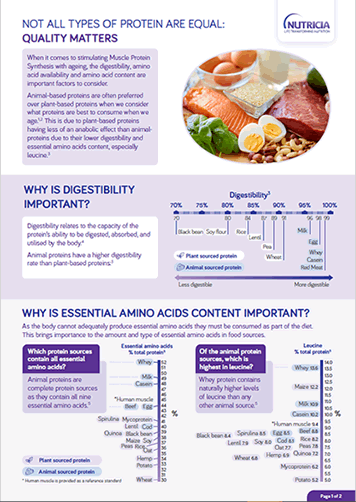Protein quality, not just quantity, matters with ageing

After the age of 40, muscle mass and strength decline at an annual rate of 1-2% and 2-5% respectively1-3. By the age of 80, ~30% of muscle mass and ~50% of muscle strength is lost4,5. A marked loss in muscle strength, mass and function is classified as sarcopenia 6.
It is hypothesized that age-associated anabolic resistance, a blunted response to anabolic stimuli such as dietary protein or exercise, is one of the primary reasons we lose muscle mass with age7-10.
A combined approach of exercise (particularly resistance-based) and higher protein intake supports the maintenance of muscle mass and function PLUS optimizing not only the quantity but the quality of the protein matters.
Complete the form below to download the Protein Infographic and to learn more about protein quality and why it matters as we age.
Download Protein Infographic
References
- Kirk, et al Australasian journal on ageing. 2020 Oct;39:3-10.
- Goodpaster, et al The hournal of gerentology series A: biological sciences and medical sciences, 2006 Oct 1;61(10):1059-1064.
- Daly, BMC geriatrics. 2013 Dec;13(1):1-9.
- Janssen, et al Journal of applied physiology. 2000 Jul 1.
- Dodds, et al PloS one. 2014 Dec 4:9(12):e113637.
- Cruz-Jentoft, et al Age and ageing. 2019 jan;48(1):16-31.
- Burd, et al Exercise and sport sciences reviews. 2013 Jul 1;41(3):169-73
- Bauer, et al Journal of the American Medical Directors Ass. 2013 Aug 1;14(8):542-59.
- Wolfe, et al Jama 2008 299(24), pp.2891-2893
- Morley, et al Journal of the American Medical Directors Ass. 2010 11(6), pp.391-396
